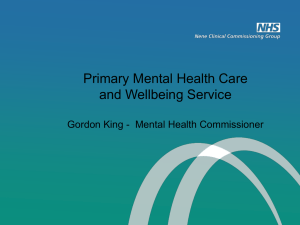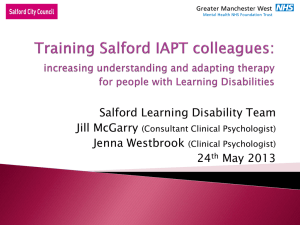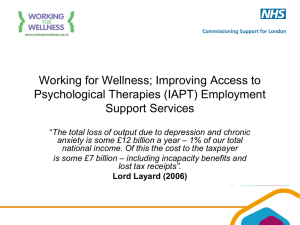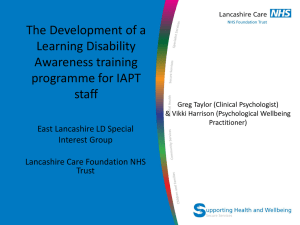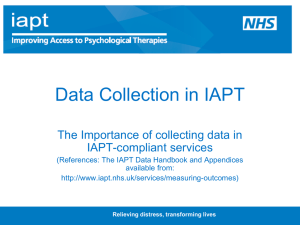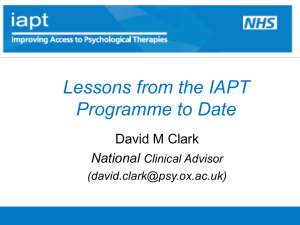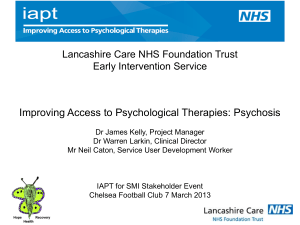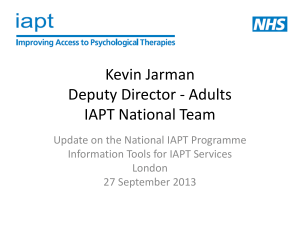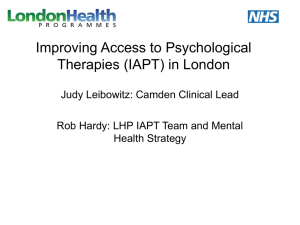Fig 1: Primary Care Trust (PCT) Distribution Histogram: IAPT
advertisement
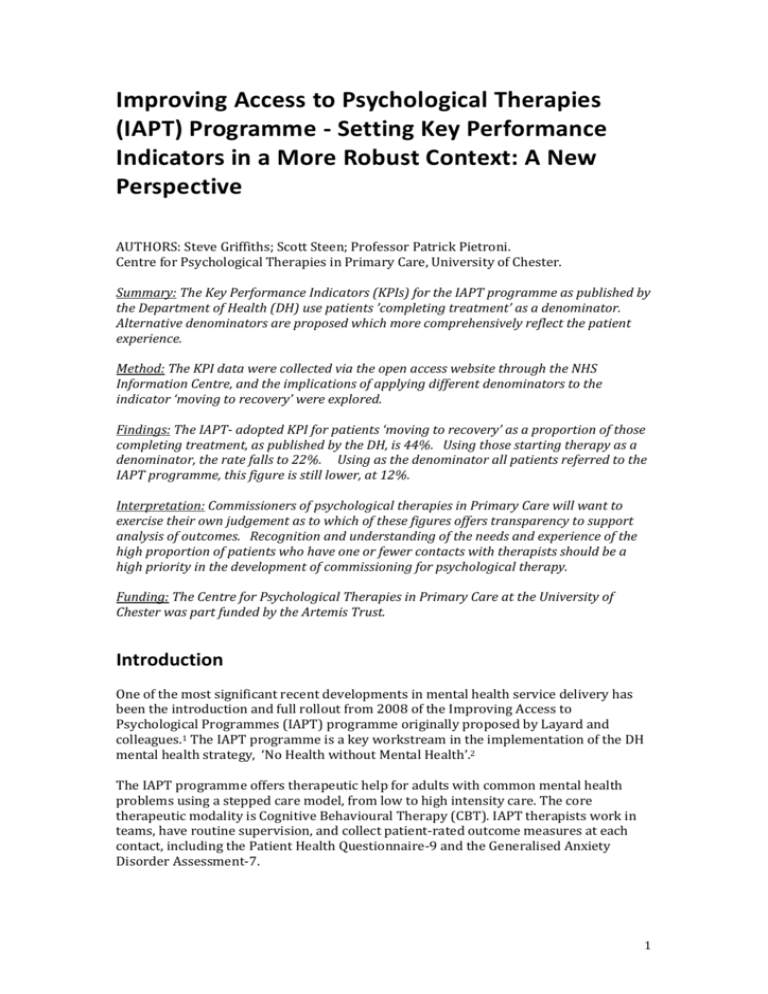
Improving Access to Psychological Therapies (IAPT) Programme - Setting Key Performance Indicators in a More Robust Context: A New Perspective AUTHORS: Steve Griffiths; Scott Steen; Professor Patrick Pietroni. Centre for Psychological Therapies in Primary Care, University of Chester. Summary: The Key Performance Indicators (KPIs) for the IAPT programme as published by the Department of Health (DH) use patients ’completing treatment’ as a denominator. Alternative denominators are proposed which more comprehensively reflect the patient experience. Method: The KPI data were collected via the open access website through the NHS Information Centre, and the implications of applying different denominators to the indicator ‘moving to recovery’ were explored. Findings: The IAPT- adopted KPI for patients ‘moving to recovery’ as a proportion of those completing treatment, as published by the DH, is 44%. Using those starting therapy as a denominator, the rate falls to 22%. Using as the denominator all patients referred to the IAPT programme, this figure is still lower, at 12%. Interpretation: Commissioners of psychological therapies in Primary Care will want to exercise their own judgement as to which of these figures offers transparency to support analysis of outcomes. Recognition and understanding of the needs and experience of the high proportion of patients who have one or fewer contacts with therapists should be a high priority in the development of commissioning for psychological therapy. Funding: The Centre for Psychological Therapies in Primary Care at the University of Chester was part funded by the Artemis Trust. Introduction One of the most significant recent developments in mental health service delivery has been the introduction and full rollout from 2008 of the Improving Access to Psychological Programmes (IAPT) programme originally proposed by Layard and colleagues.1 The IAPT programme is a key workstream in the implementation of the DH mental health strategy, ‘No Health without Mental Health’.2 The IAPT programme offers therapeutic help for adults with common mental health problems using a stepped care model, from low to high intensity care. The core therapeutic modality is Cognitive Behavioural Therapy (CBT). IAPT therapists work in teams, have routine supervision, and collect patient-rated outcome measures at each contact, including the Patient Health Questionnaire-9 and the Generalised Anxiety Disorder Assessment-7. 1 Recovery rates and outcomes Commissioners have data from the IAPT programme through monitoring of patients’ progress at every point of contact with an IAPT worker. Patient-reported outcome measures (PROMs) are used to inform a judgement of whether a patient is above or below clinical “caseness”, or in other words, considered to be suffering from a mental illness.3 When a patient is considered to have moved below clinical “caseness” they are determined to be “moving to recovery”. There is a minimum required response rate per patient of 90% of required monitoring according to the IAPT Data Handbook v2.0.1. IAPT collects Key Performance Indicators (KPIs) on each service as an agreed mechanism for measuring progress (Table 1). In 2011, the IAPT National Team reported an average recovery rate of 43%, but with considerable variability between sites (from 27% to 58%).4 Methods Data collection For this project, Key Performance Indicator (KPI) data were collected via the open access website through the NHS information Centre: Specialist Mental Health Service.5 KPIs used for IAPT are presented with brief definition in Table 1. Table 1: An adapted list of KPIs and their definitions used within the IAPT service.6 Key Performance Indicator Definition 1 Number of people who have depression and/or anxiety disorders 2 No longer collected 3a Number of people who have been referred for psychological therapies 3b Number of active referrals who have waited more than 28 days from referral to first treatment/first therapeutic session (at the end of the reporting quarter) 4 Number of people who have entered (i.e. received) psychological therapies during the reporting quarter 5 Number of people who have completed treatment during the reporting quarter 6a Number of people who are "moving to recovery" of those who have completed treatment, in the reporting quarter 6b 7 Number of people who have completed treatment not at clinical caseness at treatment commencement Number of people moving off sick pay or ill-health related benefit Results As a means to support rigorous outcome analysis by commissioners, three separate methods of presenting outcomes were explored. They are presented here as Benchmarks A, B and C. 2 Benchmark A: “Moving to Recovery” as a proportion of those who completed treatment This is the favoured IAPT measure for ‘Moving to Recovery’: those “moving to recovery” (IAPT Key Performance Indicator (KPI) 6a) as a proportion of those who completed treatment (KPI 5), minus the number of people who have completed treatment who are not at clinical caseness at treatment commencement (KPI6b). KPI 6a A= x100 KPI 5 –KPI6b ‘Completed treatment’ is defined as: a count of all those who have left treatment within the reporting quarter, having attended at least two treatment contacts, for any reason including: planned completion; deceased; declined treatment; dropped out (unscheduled discontinuation); or unknown. Using this measure, the proportion of patients completing treatment who are ‘moving to recovery’ is 44%. Fig 1: Primary Care Trust (PCT) Distribution Histogram: IAPT-defined Recovery Rates: - all IAPT compliant PCTs, 2011/12 40 Primary Care Trusts 35 30 25 20 15 10 5 95-100 90-95 85-90 80-85 IAPT Adopted Recovery Rates (%) NHS Website; N=148 75-80 70-75 65-70 60-65 55-60 50-55 45-50 40-45 35-40 30-35 25-30 20-25 15-20 5-10 10-15 0-5 0 Source: NHS open access data website.5 West Essex PCT, with a 97.93% recovery rate, has been removed as an outlier.. 3 Benchmark B: “Moving to Recovery” as a proportion of those who have entered psychological therapy A more robust and transparent measure of the intervention’s effectiveness may entail use of the larger denominator of all those who entered therapy rather than only those who completed it. This is posited as Benchmark B: patients categorised as ‘moving to recovery’ (KPI 6a) as a proportion of those who entered psychological therapy (KPI 4). KPI 6a x100 B= KPI 4 This will include those who left without completing the therapy (although there is no clear KPI which is defined as “leaving the programme during the quarter” within the IAPT dataset). ‘Entered psychological therapies’ is defined as: attending first therapeutic session, which may be during the same appointment as initial assessment. Using this measure, 24% of those entering psychological therapy are found to be moving to recovery. Fig 2: PCT Distribution Histogram: Patients who were "Moving to Recovery” as a proportion of those “Entering Psychological Therapy”: all IAPT compliant PCTs, 2011/12 Primary Care Trusts 45 40 35 30 25 20 15 10 5 90-95 95-100 85-90 80-85 75-80 70-75 65-70 60-65 55-60 50-55 45-50 40-45 35-40 30-35 25-30 20-25 15-20 5-10 10-15 0-5 0 Proportion of those Entering Psychological Therapies that are "Moving to Recovery" (%) NHS Website; N=149 Source: NHS open access data website from 149 PCTs that were IAPT compliant.5 4 Benchmark C: “Moving to Recovery” as a proportion of patients referred A third way of assessing outcomes is to identify those who are “moving to recovery” as a proportion of those who have been referred to the IAPT programme: patients categorised as ‘moving to recovery’ (KPI 6a) as a proportion of those who have been referred for psychological therapies (KPI 3a). KPI 6a C= x100 KPI 3a The proportion of patients ‘moving to recovery’ by this measure is 12%, with services ranging anywhere between 0% and 35% (IQR: 10% to 18%). Fig. 3: PCT Distribution Histogram: Patients who were "Moving to Recovery” as a proportion of those “Referred for Psychological Therapies”: all IAPT compliant PCTs, 2011/12 60 40 30 20 10 Rate of those being Referred for Psychological Therapies that are"Moving to Recovery" (%) NHS Website; N=149 95-100 90-95 85-90 80-85 75-80 70-75 65-70 60-65 55-60 50-55 45-50 40-45 35-40 30-35 25-30 20-25 15-20 10-15 5-10 0 0-5 Primary Care Trusts 50 Source: NHS open access data website from 149 PCTs that were IAPT compliant.5 Table 2 - Comparison of the Three Alternative Denominators for “Moving to Recovery” data Benchmark A % of those who completed treatment Benchmark B % of those who entered psychological therapy Benchmark C % of patients referred Total 43·72 23·90 11·86 Lowest Quarter 38·64 18·41 9·73 Median 44·66 21·90 13·10 Highest Quarter 49·64 27·30 17·62 5 Discussion – The Need for Further Analysis to Enable Scrutiny to Inform Commissioning Similar concerns to those raised here about the adequacy of IAPT recovery measures available to commissioners have been raised in a recent report by the Centre for Social Justice.6 The authors argue that the evidence base claimed for recovery rates for IAPT is flawed. “IAPT figures claim recovery as over 40 per cent… but from the point of view of commissioners and referring GPs, 86 per cent are not being helped by the IAPT service.” An earlier study of progress made by sites in the first rollout year of the programme (2008/9) suggests that 53% of referrals had one or fewer contacts with the programme, including 42% who were not assessed.7 Recognition and understanding of the needs and experience of these patients is as important as measuring the outcomes of those who completed more than one treatment session. The DH is committed to spending an additional £400 million in the 4 years to 2014/15 to support the rollout of IAPT. Given this level of investment, coupled with the introduction of Any Qualified Provider (AQP) to psychological therapies in primary care, including IAPT, it is imperative that outcome data should be widely available in a form: a) that helps commissioners to understand the nature of the patient journey through IAPT from referral, and b) enables accurate cost-benefit analyses Conclusion This study’s key finding is that the proportion of patients ‘moving to recovery’ depends on which of the three calculations is used. The difference between the method favoured by the IAPT programme (43·72%) and the proportion of all referrals (11·86%) is too large to be ignored. Commissioners of psychological therapies in Primary Care will want to exercise their own judgement as to which of these figures offers transparency to support analysis of outcomes. Recognition and understanding of the needs and experience of the high proportion of patients who have one or fewer contacts with therapists should be a high priority in the development of commissioning for psychological therapy. References 1 Layard R, Bell S, Clark DM, Knapp M, Meacher M, Priebe S. The depression report: A new deal for depression and anxiety disorders. London School of Economics 2006; http://cep.lse.ac.uk Available at. Centre for Economic Performance Report. 2 Department of Health. No Health without Mental Health: a cross-government mental health strategy for people of all ages. London: DH, 2011. 6 http://www.iapt.nhs.uk/silo/files/no-health-without-mental-health.pdf (accessed November 12, 2012). 3 IAPT Key Performance Indicator. Technical Guidance for Adult IAPT Services 2012/13 Version 1.0.http://www.iapt.nhs.uk/silo/files/iapt-kpi-technicalguidance-201213-.pdf (accessed November 12, 2012). 4 IAPT National Team. Enhancing Recovery Rates in IAPT Services: Lessons from year one. NHS, 2011. http://www.iapt.nhs.uk/silo/files/summary-of-enhancingrecovery-rates-iapt-year-one-report-oct-2011-.pdf (accessed November 12, 2012). 5 NHS Information Centre for Health and Social Care.NHS specialist mental health services. http://www.ic.nhs.uk/statistics-and-data-collections/mentalhealth/nhs-specialist-mental-health-services (accessed November 12, 2012). 6 Callan S, Fry B. Completing the Revolution: Commissioning effective talking therapies. London: Centre for Social Justice 2012; 46p. 7 Glover G, Webb M., Evison F. Improving Access to Psychological Therapies: A review of the progress made by sites in the first rollout year: North East Public Health Observatory, July 2010. Contributions: Steve Griffiths: - Senior Research Fellow, CPTPC Scott Steen: - Research Assistant/PhD Student Prof. Patrick Pietroni: - Director of CPTCP Conflict of Interest: None No support from any organisation for the submitted work; no financial relationships with any organisations that might have an interest in the submitted work in the previous three years, no other relationships or activities that could appear to have influenced the submitted work. Acknowledgement: We are very grateful to the Artemis Trust for supporting this research. 7 Address of Correspondence The Centre for Psychological Therapies in Primary Care PO BOX 4813 Shrewsbury SY1 9JU Email cptpc@chester.ac.uk The Corresponding Author has the right to grant on behalf of all authors and does grant on behalf of all authors, an exclusive licence (or non exclusive for government employees) on a worldwide basis to the BMJ Publishing Group Ltd and its Licensees to permit this article (if accepted) to be published in BMJ editions and any other BMJPGL products and sublicences to exploit all subsidiary rights, as set out in our licence ( http://resources.bmj.com/bmj/authors/checklists-forms/licence-for-publication). 8
